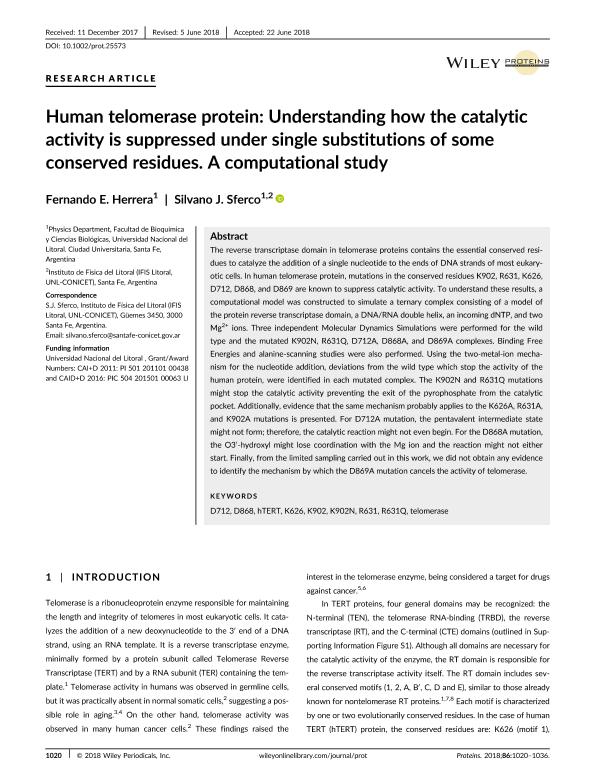Artículo
Human telomerase protein: understanding how the catalytic activity is suppressed under single substitutions of some conserved residues. A computational study
Fecha de publicación:
11/2018
Editorial:
Wiley-liss, div John Wiley & Sons Inc.
Revista:
Proteins: Structure, Function And Genetics
ISSN:
0887-3585
Idioma:
Inglés
Tipo de recurso:
Artículo publicado
Clasificación temática:
Resumen
The reverse transcriptase domain in telomerase proteins contains the essential conserved residues to catalyze the addition of a single nucleotide to the ends of DNA strands of most eukaryotic cells. In human telomerase protein, mutations in the conserved residues K902, R631, K626, D712, D868, and D869 are known to suppress catalytic activity. To understand these results, a computational model was constructed to simulate a ternary complex consisting of a model of the protein reverse transcriptase domain, a DNA/RNA double helix, an incoming dNTP, and two Mg2+ ions. Three independent Molecular Dynamics Simulations were performed for the wild type and the mutated K902N, R631Q, D712A, D868A, and D869A complexes. Binding Free Energies and alanine-scanning studies were also performed. Using the two-metal-ion mechanism for the nucleotide addition, deviations from the wild type which stop the activity of the human protein, were identified in each mutated complex. The K902N and R631Q mutations might stop the catalytic activity preventing the exit of the pyrophosphate from the catalytic pocket. Additionally, evidence that the same mechanism probably applies to the K626A, R631A, and K902A mutations is presented. For D712A mutation, the pentavalent intermediate state might not form; therefore, the catalytic reaction might not even begin. For the D868A mutation, the O3′-hydroxyl might lose coordination with the Mg ion and the reaction might not either start. Finally, from the limited sampling carried out in this work, we did not obtain any evidence to identify the mechanism by which the D869A mutation cancels the activity of telomerase.
Archivos asociados
Licencia
Identificadores
Colecciones
Articulos(CCT - SANTA FE)
Articulos de CTRO.CIENTIFICO TECNOL.CONICET - SANTA FE
Articulos de CTRO.CIENTIFICO TECNOL.CONICET - SANTA FE
Articulos(IFIS - LITORAL)
Articulos de INST.DE FISICA DEL LITORAL
Articulos de INST.DE FISICA DEL LITORAL
Citación
Herrera, Fernando Enrique; Sferco, Silvano Juan; Human telomerase protein: understanding how the catalytic activity is suppressed under single substitutions of some conserved residues. A computational study; Wiley-liss, div John Wiley & Sons Inc.; Proteins: Structure, Function And Genetics; 86; 10; 11-2018; 1020-1036
Compartir
Altmétricas




